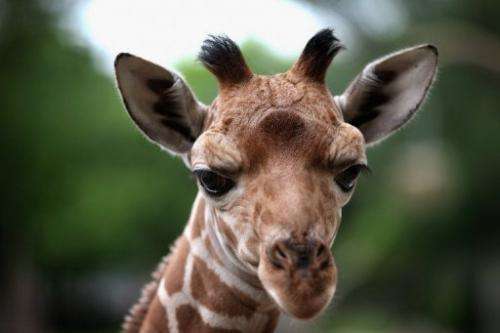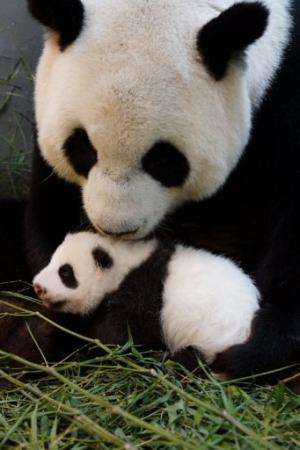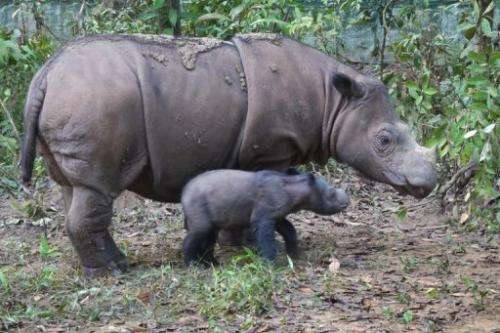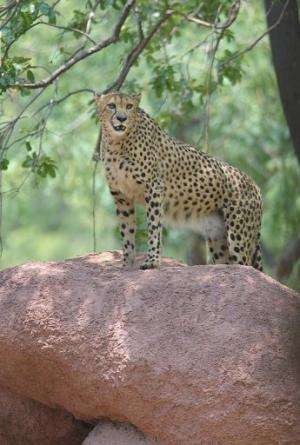Zoos rethink role as matchmaker for endangered species

Like an online dating site for endangered species, many zoos use computerized matchmaking to mate animals in captivity in hopes of saving some of the world's most vulnerable creatures.
The tools of the trade range from frozen panda sperm, to genetic databases to ultrasounds for hefty rhinoceroses.
But like dating everywhere, it gets expensive, complicated and doesn't always work.
After more than three decades of efforts, some experts are taking a fresh look at modern-day breeding tactics. Zoos, they say, cannot keep pace with the high costs of shipping animals from one facility to another, as the loss of wild habitat pushes more and more creatures to the brink of extinction.
A movement to improve captive breeding began in the late 1970s when scientists realized that some zoo-held baby giraffes, gazelles and deer were more likely to die if inbred.
"That really caused a sea change in zoos because they realized they had to be better at managing captive populations," recalled David Wildt, head of the Center for Species Survival at the Smithsonian National Zoo.
Today, survival plans exist for more than 500 species, including cheetahs, Asian elephants and black-footed ferrets.
The genetic data of captive specimens is fed into computers so scientists can determine the most diverse matches for each individual.
Sometimes the plans work, as for the scimitar-horned oryx, a graceful type of African antelope that was declared extinct in the wild in 2000 due to overhunting and habitat loss.
Thousands have been bred in captivity. Some have already been reintroduced in Tunisia and there are plans to release more soon, according to the Sahara Conservation Fund.
China's giant panda breeding program has also been "extraordinarily successful," said Wildt.
Beijing maintains a core population of captive pandas and rents some out to mate in zoos around the world, with the caveat that the animals must eventually return home.
"They only have one shot per year," said Pierre Comizzoli, a research scientist who works with the solitary bears at the National Zoo in Washington.

The 220-250 pound (100-114 kilogram) pandas rarely manage the position needed to conceive naturally so zoo experts resort to artificial insemination.
"We have to anesthetize the male and then stimulate the male under anesthesia and that is the way that we get the semen," Comizzoli explained. Then, they have to wait the entire three-to-five month gestation period to see if the female was even impregnated.
Most years, the attempts have failed. One panda cub born in 2005 at the National Zoo has survived to adulthood. This year experts for the first time used samples from two different bears, including one from a San Diego zoo.
A so-far healthy, baby giant panda was born on August 23 though its paternity will remain a mystery until the DNA tests come back. A second cub emerged stillborn a day later.
For other species, like the critically endangered Sumatran rhinoceros, inbreeding is now the only option left, US zookeepers say.
In the wild, as few as 100 remain in Indonesia and Malaysia. The females ovulate only if a potential mate is nearby—which isn't always the case.
A Cincinnati Zoo team began working with Sumatran rhinos in the 1990s and finally succeeded in getting a pair to breed in 2001, producing the world's first calf born in captivity in 112 years.
Now, that zoo's sole female, Suci, is sexually mature. Her only potential mate in captivity in the United States is her brother, Harapan.
An attempt to mate the siblings is expected to begin soon.
"We are in a really tough spot and we just don't have any other options," said Terri Roth, vice president of conservation and science. "Unless Indonesia were to capture more animals... we don't have the genetic diversity that we need."
Roth said she and her fellow scientists have spent more than 30 years trying to protect the wild rhino population and to improve their captive breeding program but said both efforts "haven't succeeded as we hoped."

Cost is a key obstacle. Maintaining a pair of Sumatran rhinos in Cincinnati ran up to $263,000 in 2011, she said. But the larger problem is the rapid loss of animals in the wild due to deforestation and poaching.
Costs are high for breeding small animals, too. Wildt said his facility spent a quarter of a million dollars in a single year to breed 40 black-footed ferrets.
Chemistry can also be an obstacle. Sometimes animals, especially cheetahs and other big cats, just don't agree with the computer match-up.
"Cats are extremely tricky to breed in captivity," Comizzoli told AFP. "If they don't like each other they are going to kill each other."
For Wildt, the future lies in maintaining herds of animals in large, fenced-in spaces, like the 3,200 acres (1,300 hectares) he oversees at the Smithsonian's facility in rural Virginia.

Growing up in groups, away from humans will help them to be released later. It may also help reintroduce some choice in the mating process and lead to better quality offspring, he said.
"There is a lot of discussion going on in the zoo community in North America and I think also in Europe about the fact that genetic management programs that have been in place now for over 30 years are not achieving their goals," said Wildt.
Even when zoos manage to maintain 90 percent genetic diversity, "there are very few examples of successful reintroduction in the wild," he added.
"This is the new reality," he said. "There is going to have to be some sort of management of any kind of wildlife if we want to make sure they are going to be around for a long time."
© 2013 AFP



















